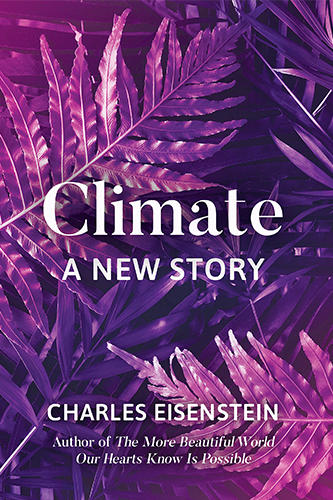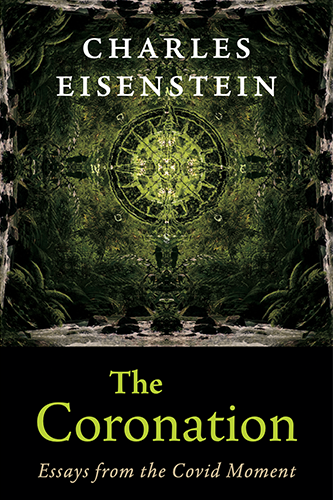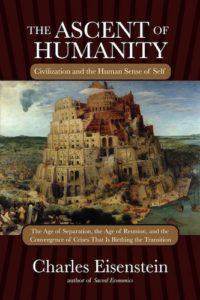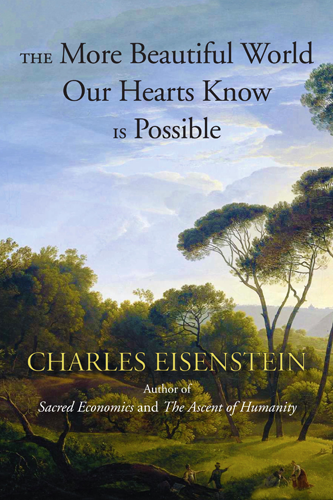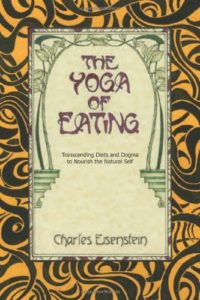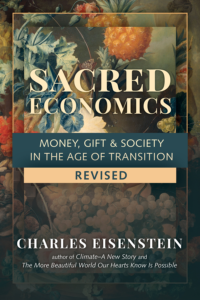The Ascent of Humanity
Chapters
Chapter 2: The Origins of Separation
Images of Images
The separate human realm that grew up around stone and fire, language, number, and time-binding finds explicit reflection in the world of images. Representational art—pictures of things—is quite literally a human-made copy of the world, the world interpreted through human eyes. Extending now far beyond art, the separate realm of images has increasingly taken on a life of its own, diverging from the reality it once represented. The fake images of politicians and corporations, along with our own self-images that we project, are part of a phony world, a realm of appearances. As these appearances diverge more and more from reality, so also grows our intuition of an inauthenticity to life. This section explores the evolution of the world of images that immerses us today.
Living in the Age of Separation, we tend to see and understand art either as a depiction (of things, ideas, or emotions) mediating human and nature, or as an appendage to life offering aesthetic pleasure. Representation, or decoration. But could images serve another purpose?
Representational paintings and sculpture are quite new on the face of the earth. Neanderthals did not make them (though they apparently did adopt the use of pigments, possibly by diffusion from modern humans).[52] The earliest known representational paintings were found in a Namibian cave dating back some 59,000 years, followed by an abundance of paintings throughout Africa, Europe, and Australia starting around 30,000 years ago. Most of them depict animals, and are conventionally interpreted as attempts to bring luck to the hunt through “sympathetic magic”. Similarly, magical or ritual uses are ascribed to the earliest sculptures, which also date to this period and which appear to be fertility symbols.
In other words, scholars explain Paleolithic art as an attempt to affect the real world by manipulating its representation. It was a bumbling attempt, though—the kind of magic we have replaced with technology that actually works. Ha ha, those poor primitives actually thought pictures on a wall would actually influence the events those pictures depicted. Consider, however, that this interpretation is yet another projection—a projection of our own anxiety and separation onto primitive artists. Perhaps it is we, and not they, who manipulate a matrix of appearances under the delusion that it is the real thing.
We should be more cautious in our blithe assumption that hunter-gatherer art was representational in the sense we understand it. That a picture of an animal is separate and distinct from the real animal seems obvious to us, but not to the primitive mind. As Joseph Epes Brown observes, “Symbols in traditional Native American art. . . instead of simply pointing to what they represent actually become what they represent.”[53] From the modern perspective we tend to wink patronizingly at such superstitious primitivism, those poor fools who actually thought their paintings would bring luck to the hunt, and for that matter at all the rituals of every “primitive” society that has ever existed on earth, as if we were past all that now, as if technology has replaced the illusory control of nature that subsists in ritual with real control. But consider for a moment: if every human culture up until recent times believed in the power of magic ritual, is it not conceivable that there was something to it? This belief was universal among pre-agricultural peoples. Perhaps it is we moderns who have forgotten the truth, and lost touch with basic principles of the universe that every other culture knew. In any event, ostensibly representational art need not indicate a dualistic mindset; more likely, the dualism grew over time as other developments contributed to a great forgetting of the original magical significance of art.
Significantly, as technology and agriculture furthered the distance between human beings and nature, the depictions of artists became more and more stylized, standardized, and abstract, losing the vibrant aliveness of the Lascaux and Chauvet cave paintings, which seemed somehow to capture the spirit of the animals depicted. Compare these to the well-known stylized figures of the agricultural society of ancient Egypt. It is as if the further the artist is removed from nature, the less able he or she is to be a direct channel for the infinity of the real world that somehow impregnates the truly great works of art, and the more necessary it becomes to control and confine the wild through its representation. As John Zerzan puts it, “art turns the subject into an object,” confining the infinity of the real world within the conceptual and perceptual framework of a human artist.
There remains the possibility, even for a modern artist, to achieve a momentary freedom from culture and domestication, but this requires tapping into her own inner infinity: the spontaneous, undomesticated spirit that lies deeply buried under the vast weight of culture. Such art is described in the Gurdjieff tradition as “objective art,” not because it reifies representational forms, but precisely because, like Paleolithic images, its primary existence is not representation but rather a thing in and of itself; that is, it is real. Such art has genuine power. Its presence moves us and can indeed change the world.
As human beings turned from the Original Religion toward the dualistic religions of agriculture, the magical import of art transformed from an inherency in the object itself to an inherency in its representational power. Whereas pre-alienation peoples (animists) believed that the entire universe, animate and inanimate, is living spirit manifest, as separation grew human beings separated spirit out from matter and conceived for the first time that some things might be more spiritual than others. Images and by extension rituals became, as John Raulston Saul puts it, “a magic trap.” Its power no longer resided in what it was (a unique convergence of everything else in the universe), but in what it symbolized, the spirit it contained. In parallel with the concurrent conception of a soul inhabiting, but separate from, a non-spiritual body, the magical item became a vessel not magical in and of itself. It became magical only because of what was invested in it. This stands in contrast to anything that has a power in and of itself not related to a dualistically-conceived “content” separate from form. The parallel with the non-semantic meanings of the sounds of the lingua Adamica is exact. Shaker furniture is an example of this kind of “objective” art: separate neither from form nor function, it lies in the perfection of both.
As the magical power of art came to be understood in terms of its representational content, then it stands to reason that artists would pursue perfection in their images, which according to this belief would be tantamount to perfect control over the world. Yet when Raphael, Michelangelo, and Leonardo da Vinci made the final technical breakthroughs in perspective around the year 1500, nothing magical happened. Saul writes, “In the West the painter’s and sculptor’s job has been to design the perfect trap for human immortality.”[54] The ambition was to make representation real, the same ambition that lives on in the latest version of the trap for immortality: the software simulation of consciousness in a VR world. We now live almost wholly in a manufactured reality, a world of images, but really nothing has changed. Using finite methods to approximate the infinite, using representation to approximate reality, we succeed only in building a taller Tower. Can it ever reach the sky?
The solution of the puzzle of perspective was not just a technical breakthrough, but a conceptual shift as well. Perspective freezes objects in time by assuming a single viewpoint at a single moment. “Before the 14th century there was no attempt at perspective because the painter attempted to record things as they are, not as they look.”[55] Perspective painting records objects as they look, at a given moment of time, thereby implicitly subordinating reality to the human observer and affirming the fundamental dualism of self and world. Here is the separate “I am” of Descartes, a discrete point of perception gazing out upon the Other. Perhaps the Medieval painters were not awaiting a mere technical breakthrough as the end result of successive advances, but simply were not interested in even attempting perspective at a time when the modern conception of self had not fully matured, and when measured time had not fully supplanted the rhythms of nature.
There is an element of hubris in the capturing of reality that is the perfect image; perhaps this explains the deep suspicion many religious traditions have of images of the divine or even of humans, animals, and objects. Judaism and Islam do without them altogether, as did Buddhism until Alexander the Great brought Greek culture, with its obsession with mortality and, not coincidentally, with images, to India.[56] There are also many cultures that resist having their photographs taken, intuiting perhaps the hubris and futility of the pseudo-immortality it suggests, or the Faustian exchange of a moment in time, which is real, for the frozen representation of a moment, which is not. Indeed I have noticed that cameras and—even worse—videotaping tend to detract from the happy events they are supposed to preserve on film. Taking photographs at birthday parties and weddings to preserve those happy memories substitutes an image for an experience, and can sometimes imbue the event with a staged feel, as if it were not real, as if it were an enactment to be enjoyed later. It is as if we are uncomfortable with real moments and prefer to experience them from a distance, second-hand. In the most extreme case, the photographic or video recording of the event comes to completely define the event itself—certainly the case in the realm of public relations and politics.
A small but for some people significant way to reduce the alienation of modern life is to put down the camera and participate fully in the moment, rather than trying, futilely, to preserve the moment on film. The compulsion to record everything bespeaks the underlying anxiety of modern life, the conviction, stemming from measured time, that our lives are slipping away from us day by day, hour by hour, moment by moment. Perhaps if I photograph them, those precious moments of my children’s childhood will always be there, preserved for eternity. I have noticed, though, that when I look at my sons’ baby pictures my main emotion is wistfulness, a regret that I did not truly and fully appreciate those precious, unique times. I can seldom look at my most treasured photographs without feeling sadness and regret. The very effort to possess and preserve those moments diminishes them, just as technology in general leaves us alienated from and more afraid of the very world it attempts to control.
It is much better to enjoy each beautiful moment in the serene knowledge that an infinity of equally yet differently beautiful moments await. At the same time, the awareness of each moment’s transience helps us appreciate it all the more, if only we don’t succumb to the illusion, offered for example by photography, that it can be made permanent. That illusion robs life of its urgency and intensity, substituting for it an insipid complacency that conceals our buried unmet hunger for real experience. And that unmet hunger, in turn, fuels an endless appetite for the vicarious imitation experiences to be found in television, movies, amusement parks, spectator sports, and—the last gasp—reality TV.
Buddhism (and, I could argue, the esoteric teachings of all religions) recognizes the suffering implicit in the attempt to make permanent that which is intrinsically impermanent. The beautiful sand paintings made by Tibetan monks and Navajo Indians, which by the nature of their medium last a very short time (even when they aren’t purposefully destroyed the next day), demonstrate an important principle: the value of beauty does not depend on its preservation. The modern mind tends to think of their creation as a waste of time—creating something beautiful only to destroy it again—and wants to preserve it in a museum, derive some “benefit” from it. This way of thinking, in which we mortgage the present moment to future moments, is precisely the mentality of agriculture, in which we must sow in order to reap, in which the future motivates and justifies the labor of the present. When we photograph, record, and archive the present, we are driven by the same anxiety as the agriculturalist who knows that unless he stores up grain now, there will be scarcity in the future. Just as the agriculturalist no longer trusts (as hunter-gatherers do) in Providence, the easy bounty of nature, so also are we compelled to save up beautiful moments as if their supply were limited.
When nothing magical happened when the painted image was perfected, it did not take long for disappointment and eventually desperation to infect the world of art. Saul writes, “For some twenty years after Raphael’s discovery, craftsmen celebrated their triumph with an outpouring of genius. But gradually the subconscious failure beneath this conscious success began to slow them and to darken their perspective. The viewer has only to watch Titian’s opulence and sensuous joy gradually turn tragic. With no room left for progress, the image turned and dodged and circled back and buried itself like an animal chained to its own impossible promise, searching for some way to get beyond the mortality of the real.”[57] But try as it might, through all the contortions of the successive waves of artistic “movements,” from Impressionism’s demonstration of the facticity of the image to Cubism’s shattering of perspective, the image cannot escape from the reality that it is nothing more than paint on canvas.
Further perfections of the image only reinforced the disappointment. Photography, then motion pictures, then holography, similarly failed to produce magical results; that is, actual control of reality via control over its representation. Yet, unwilling to admit defeat, we press on with “virtual reality,” a fitting metaphor for the dead end to which our separation of self has brought us. The separate human realm that originated with the circle of the campfire is nearly complete now—a wholly artificial reality. We have arrived, only to find ourselves feeling more lost than ever before.
The second-hand pseudo-experiences that today’s entertainment media provide assuage our hunger for real experience temporarily, but in the end only intensify that hunger. Like any object of addiction, they are a counterfeit that leaves the real need unmet—a shortcoming that is temporarily disguisable by increasing the dose. Movies and music for example have become progressively more intense, louder, and faster-paced over recent decades. Computer 3-D animation has brought to fruition the painters’ old dream of the perfect image, even a moving image, yet the inconvenient fact remains that however perfect, the image can never be real, and the virtual world can never be a real world. And this phenomenon is not limited to the entertainment media. John Zerzan writes, “Everyone can feel the nothingness, the void, just beneath the surface of everyday routines and securities.” We live in a world of images, of representations, that separate us from real experience; we then try to meet the hunger for reality with yet more images. The further intensification of dosage is therefore an inevitability—we can never get enough. It is like trying to assuage hunger by chewing gum.
The 2004 Presidential campaign offers an example of just how far we have become lost in a world of images disconnected from reality. In the words of journalist Matt Taibbi, “The whole thing could easily be done in a movie studio.”[58] It is a world in which nothing is real and everything is staged, in which every action is calculated and every encounter scripted according to how it will look. The inauthenticity is palpable as candidates everywhere obsess about their image. Speaking of the Kerry campaign, Taibbi explains, “All they want to do is hit those dial survey words they know are going to impress voters. Change. Leadership. Strength. These are literally infantile concepts that they want to communicate to you.” The delusion that image trumps reality has even extended to official U.S. policy in the infamous “brand America” campaign to improve America’s “image” in the Middle East.
The world of images of which I speak is not limited to corporate identity systems and the posturings of politicians. Even on an individual level, we tend to be obsessed with appearances, with projecting an acceptable image of ourselves to the world. I’m not just talking about the superficialities of fashion, but of the subtle masks and poses we wear as shields in a world filled with strangers. The unreality of the modern world projects onto our faces, into our voices, into our thoughts; hence the mounting desire to “get real”, the search for authenticity. Just as words are losing their meaning, so also have images lost their power and mystique. Leibniz and other thinkers in the Age of Reason believed in the possibility of inventing a perfect language so congruent to reality that no false utterances would even be possible, not realizing the object of their search existed prior to language and could never be reached by increased precision of representation, but only by transcending representation altogether. No language has ever before had the number of words that exist in English, the profusion of precise technical terms for increasingly fine divisions of reality, yet true meaning recedes all the further. In the same way, images of reality proliferate toward ubiquity, to the point where the latest cellular phones have digital cameras built in, and video cameras record our every movement in public space, but they don’t seem to mean anything anymore. The most graphic cinematic images of violence leave us unmoved, because we know that despite their near-perfect verisimilitude, they are not real. Nothing is, in a world of images.
What power images still bear is rapidly fading as it becomes easier and easier to manufacture perfect images unconnected to reality. Shortly before the Abu Ghraib prison abuse scandal, a photograph circulated of a smiling GI and an Iraqi boy next to him cheerfully holding up a sign that said “This man raped my mother and killed my father.” The sick joke was that the boy didn’t understand English and was unwittingly humiliating himself. But then other versions of the photo circulated with a different message on the sign, and it was impossible to tell which was authentic.
Yet even when their authenticity is not in question, somehow photographs are losing their power to shock, as the muted American response to the Abu Ghraib images testifies. Where is the outrage, the disgust, the national shame? Perhaps because of the increasing ubiquity of depictions of graphic violence and diabolical cruelty in the entertainment media, we have seemingly become inured to violent or tragic images even when they are not fictitious. We treat them as just so many pixels—does not life go on as usual anyway?
A further symptom and consequence of the divorce between reality and image is the gradual migration of art to the position of irrelevance that the dualistic distinction between art and craft implies. Art is concerned with aesthetics, craft with function. In medieval times, painters were considered to be craftsmen performing a useful social, political, and religious function, and it was not until the 18th century that a distinction between fine arts and useful arts was conceived.[59] As Saul wryly observes, “Put another way, by the eighteenth century society was beginning consciously to doubt that art was useful.” By the next century the first museums for purely aesthetic purposes were established. The aesthetic function of art, today accepted almost universally, virtually consigns it to irrelevance, a pretty flourish divorced from function. As Zerzan (p. 68) puts it, “Kierkegaard found the defining trait of the aesthetic outlook to be its hospitable reconciliation of all points of view and its evasion of choice. This can be seen in the perpetual compromise that at once valorizes art only to repudiate its intent and contents with ‘well, after all, it is only art.’”
Maybe this is why I, along with all little children, detest art museums. Ordinarily I can walk ten miles without undue discomfort, but after about twenty minutes in a museum my feet get tired and I start whining for someone to buy me an ice cream cone. Museums reaffirm that art is just for looking at—don’t touch!—even as their walls and glass cases physically separate it from the rest of the world. Despite their great efforts to preserve art, which ought to validate its importance, by their very nature museums affirm art’s irrelevancy and separateness.
Going back a little further, we can call into question the distinction not just between art and craft but between art and life as well. According to Joseph Epes Brown, Native American languages have no term for art at all. He quotes James Houston as follows: “I believe that Eskimos do not have a satisfactory word for art because they have never felt the need for such a term. Like most other hunting societies, they have thought of the whole act of living in harmony with nature as their art.”[60] Later he writes, “To dismiss utilitarian items as only ‘crafts’ in this way has contributed to the tragic separation of art from life. Within created traditional Native American forms, however, there can be no such dichotomy, because art is not only the particular created form but also the inner principle from which the outer form comes into being. An art form is often seen as beautiful not just in terms of aesthetics but also because of its usefulness and the degree to which it serves its purpose.”[61]
By the foregoing critique of art I do not mean to advocate the excision of art from life, but rather the merger of these two categories. Art can be a way of life that encompasses all its dimensions. As Wendell Berry puts it,
The possibility of an entirely secular art and of works of art that are spiritless or ugly or useless is not a possibility that has been among us for very long. Traditionally, the arts have been ways of making that have placed a just value on their materials or subjects, on the uses and the users of the things made by art, and on the artists themselves. They have, that is, been ways of giving honor to the works of God. . . . There is not material or subject in Creation that in using, we are excused from using well; there is no work in which we are excused from being able and responsible artists.[62]
Such honoring of Creation—that is, the world—is utterly inconsistent with the logic of modern biology and economics. Why do anything better than it needs to be done? The dictates of biological survival and reproduction, or of economic competition, reward a certain level of excellence, but nothing beyond that, nothing motivated internally by the worker and her materials, but only externally, by the environment or the marketplace. Good enough, in other words, is good enough. I see the results of this all the time in education, in which learning is motivated by the grade. Why learn more than what is necessary for the “A”? Under the logic of the discrete and separate self, any reason to do more than good enough is always an illusion. Our very world-view has sundered art from life, rendering the former by definition frivolous or irrelevant, and the latter a dispirited caricature of itself, an empty shell. And the reuniting of these two categories, art and life, is central to the healing that will occur with the collapse of the Age of Separation.
[52] Oppenheimer, p. 120
[53] Joseph Epes Brown, Teaching Spirits, p. 71.
[54] John Raulston Saul, Voltaire’s Bastards, p. 427
[55] Zerzan, p. 22.
[56] Saul, p. 430.
[57] Saul, p. 435
[58] “Politics-a-palooza”, an interview of Matt Taibbi by Jonathan Shainin, Salon Magazine, May 12, 2005.
[59] Saul, p. 439.
[60] Brown, p. ***
[61] Brown, p. ***
[62] Wendell Berry, Sex, Economy, Freedom & Community, p. 112-113

